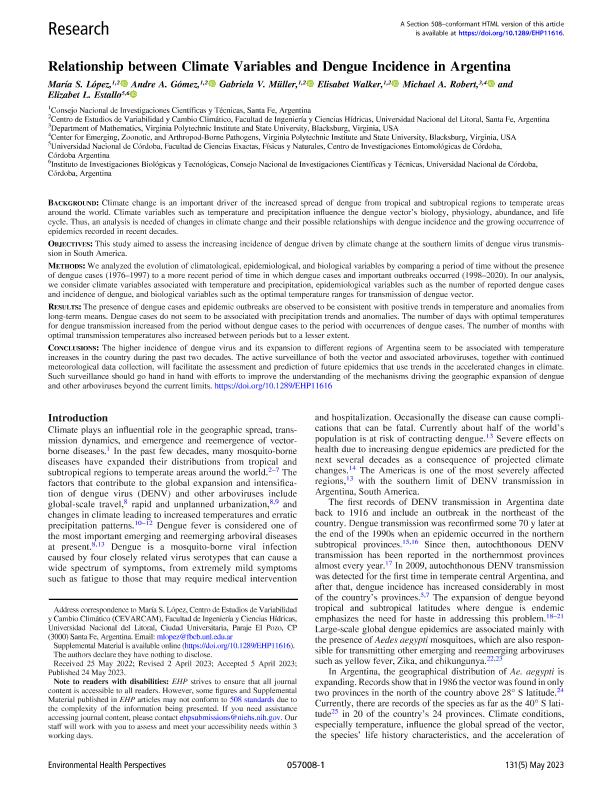Artículo
Relationship between Climate Variables and Dengue Incidence in Argentina
López, María Soledad; Gomez, Andrea Alejandra ; Muller, Gabriela Viviana
; Muller, Gabriela Viviana ; Walker, Elisabet
; Walker, Elisabet ; Robert, Michael A.; Estallo, Elizabet Lilia
; Robert, Michael A.; Estallo, Elizabet Lilia
 ; Muller, Gabriela Viviana
; Muller, Gabriela Viviana ; Walker, Elisabet
; Walker, Elisabet ; Robert, Michael A.; Estallo, Elizabet Lilia
; Robert, Michael A.; Estallo, Elizabet Lilia
Fecha de publicación:
05/2023
Editorial:
U.S. Department of Health and Human Sciences. Public Health and Science
Revista:
Environmental Health Perspectives
ISSN:
0091-6765
Idioma:
Inglés
Tipo de recurso:
Artículo publicado
Clasificación temática:
Resumen
BACKGROUND: Climate change is an important driver of the increased spread of dengue from tropical and subtropical regions to temperate areas around the world. Climate variables such as temperature and precipitation influence the dengue vector’s biology, physiology, abundance, and life cycle. Thus, an analysis is needed of changes in climate change and their possible relationships with dengue incidence and the growing occurrence of epidemics recorded in recent decades. OBJECTIVES: This study aimed to assess the increasing incidence of dengue driven by climate change at the southern limits of dengue virus transmission in South America. METHODS: We analyzed the evolution of climatological, epidemiological, and biological variables by comparing a period of time without the presence of dengue cases (1976–1997) to a more recent period of time in which dengue cases and important outbreaks occurred (1998–2020). In our analysis, we consider climate variables associated with temperature and precipitation, epidemiological variables such as the number of reported dengue cases and incidence of dengue, and biological variables such as the optimal temperature ranges for transmission of dengue vector. RESULTS: The presence of dengue cases and epidemic outbreaks are observed to be consistent with positive trends in temperature and anomalies from long-term means. Dengue cases do not seem to be associated with precipitation trends and anomalies. The number of days with optimal temperatures for dengue transmission increased from the period without dengue cases to the period with occurrences of dengue cases. The number of months with optimal transmission temperatures also increased between periods but to a lesser extent. CONCLUSIONS: The higher incidence of dengue virus and its expansion to different regions of Argentina seem to be associated with temperature increases in the country during the past two decades. The active surveillance of both the vector and associated arboviruses, together with continued meteorological data collection, will facilitate the assessment and prediction of future epidemics that use trends in the accelerated changes in climate. Such surveillance should go hand in hand with efforts to improve the understanding of the mechanisms driving the geographic expansion of dengue and other arboviruses beyond the current limits. https://doi.org/10.1289/EHP11616.
Palabras clave:
CLIMATE CHANGE
,
DENGUE
,
CLIMATIC ANOMALIES
Archivos asociados
Licencia
Identificadores
Colecciones
Articulos(CCT - SANTA FE)
Articulos de CTRO.CIENTIFICO TECNOL.CONICET - SANTA FE
Articulos de CTRO.CIENTIFICO TECNOL.CONICET - SANTA FE
Citación
López, María Soledad; Gomez, Andrea Alejandra; Muller, Gabriela Viviana; Walker, Elisabet; Robert, Michael A.; et al.; Relationship between Climate Variables and Dengue Incidence in Argentina; U.S. Department of Health and Human Sciences. Public Health and Science; Environmental Health Perspectives; 131; 5; 5-2023; 1-9
Compartir
Altmétricas



